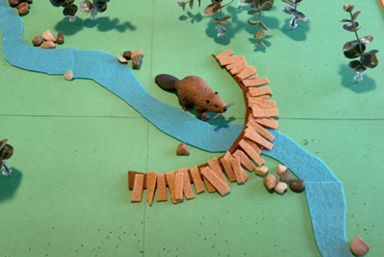Beavers: nature’s firefighters!

By Susan Mates, Treekeepers of Washington County
Smokey the Bear may be famous as the animal who helps prevent forest fires, but North American beavers, Castor canadensis, are much better at fire prevention.

Beavers are awkward on land, so they build dams to create ponds and wetlands for their own protection. Recently, scientists have noticed that these wetlands appear to protect areas by slowing the spread of wildfires.
When we think of streams, we tend to think of narrow, clear-running strips of water. But that is not really how scientists believe a stream should look. Streams look that way now because European settlers trapped millions of beavers, channelized streams and turned wetlands into farmland. A healthy stream actually looks like chaos: mud, bugs, fish, and so much brush that it is challenging to walk through. Many channels branch off and come back together. That allows pond water to slowly seep into the soil, keeping it wet and plants green.

That’s exactly how a beaver-created wetland looks. When a wildfire roars through, these areas see much less land lost to fire—about three times less—than areas that don’t have beavers. It’s so wet in those areas that fires may not be able to penetrate them at all, and that means they provide a safe place for other animals to hide out during the fires. In photo after photo, researchers can see these beaver-created oases in an otherwise charred landscape throughout the Pacific Northwest.
Even after a wildfire, beavers help to heal the landscape. Their dams and ponds filter out sediment, almost like a coffee filter, by slowing the rate at which water flows. That gives sediment time to settle to the bottom where it is less of a risk to fish and other aquatic animals. And streams without beavers are more likely to become colonized with invasive plants after a burn.
When beavers expand wetland habitats, that also cools and recharges groundwater, playing a critical part in drought reduction and slowing climate change. They diversify the micro-habitats within the stream channel, providing food and shelter for young fish, migratory birds, and a host of other animals. Their wetlands slow down the force of floods. As a keystone species, beavers have a disproportionally large effect on their surrounding ecosystem.

Since beavers are providing all of these benefits for free, you’d think we would want them everywhere, but their dams also can cause flooding and sometimes they cut down trees that people like. In Oregon, the Beaver State, beavers are classified as nuisance animals and there are few limits on hunting and trapping them. If they are removed everything else suffers. Researchers are developing ways to help us coexist happily with beavers with techniques such as installing “pond levelers” that act like bathtub overflow drains to prevent flooding.
Helping beavers to thrive will allow them to reshape the landscape to make it more resilient to fire and drought. Beavers will do all that for free, which saves governments a lot of money. They are the ecosystem engineers, and they are the professionals for that. Let’s stand back and let them get to work.
Find out more:
Read: Eager: The Surprising Secret Life of Beavers and Why They Matter, by Ben Goldfarb, Chelsea Green Publishing, 2019
Watch: Beavers and Wildfire, OPB’s Oregon Field Guide, aired 11/11/2021
Beavers and Wildfire: a stop-motion story by Emily Fairfax.
Help: The Beaver Coalition is partnering with beaver to fight wildfires and drought. Learn more and donate here.





